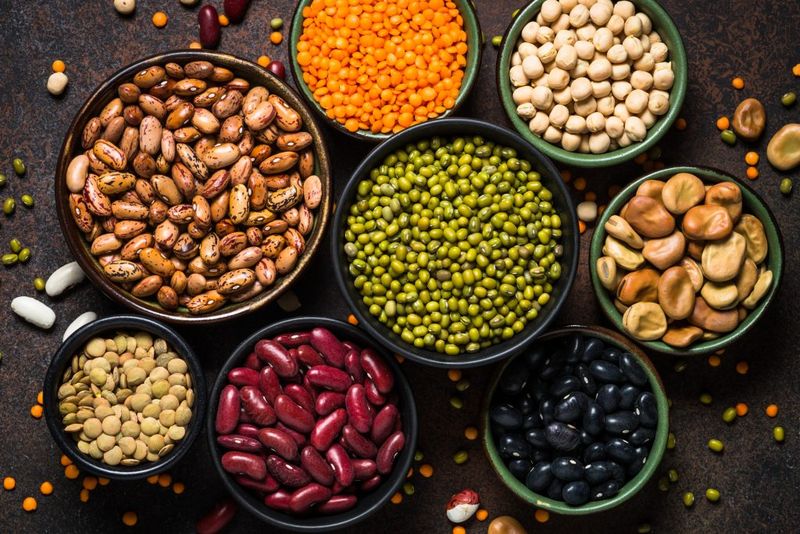ABARES lifts total estimate for five major pulses

Australia’s five major winter pulse crops are forecast to produce 3.17 million tonnes (Mt), according to estimates contained in ABARES December Australian Crop Report released yesterday.
The figure for the crops now being harvested is up 7 percent from 2.96Mt forecast in the previous quarterly report released September 5.
However, the current crop is forecast to be 26pc smaller than last year’s, with smaller lupin and lentil crops accounting for much of the difference.
While Australia’s chickpea, lupin and field pea harvests are close to over in most regions, the lentil and faba bean harvests are roughly two-thirds through.
Roughly one third of faba bean and lentil crops in South Australia and Victoria remain unharvested, and patchy rain, storms and some hail will impact yield and quality in paddocks that were soaked.
| CROP | 22-23 ha | 22-23 tns | 23-24 ha Sep | 23-24 tns Sep | 23-24 ha Dec | 23-24 tns Dec |
| Chickpeas | 398,000 | 541,000 | 427,000 | 533,000 | 427,000 | 528,000 |
| Faba beans | 305,000 | 635,000 | 266,513 | 447,229 | 268,000 | 484,000 |
| Field peas | 198,000 | 314,000 | 197,017 | 238,498 | 197,000 | 238,000 |
| Lentils | 646,000 | 1,687,000 | 645,000 | 1,228,000 | 675,000 | 1,393,000 |
| Lupins | 535,000 | 1,098,000 | 375,119 | 514,209 | 375,000 | 524,000 |
| TOTAL | 2,082,000 | 4,275,000 | 1,910,649 | 2,960,936 | 1,942,000 | 3,167,000 |
Table 1: Old-crop, and previous (Sep 2023) and current (Dec 2023) new-crop area and production estimates for Australia’s five major winter pulse crops. Source: ABARES
ABARES’ latest forecast for Queensland is a crop of 320,000t of chickpeas from 240,000ha, up on both area and production from last year’s crop of 292,000t from 200,000ha.
In New South Wales, a very dry pre-plant and growing season in the state’s north means a reduced area of 150,000ha has just been harvested to yield 165,000t, with both figures below last year’s flood-affected crop of 160,000ha which yielded 192,000t.
A much drier growing season in South Australia has the state forecast by ABARES to harvest 190,000t from 100,000ha, down from a record 300,000t from 120,000ha last year.
Victoria’s faba bean crop is forecast at 175,000t from 100,000ha, down from 200,000t harvested last year from 110,000ha.
That harvest of faba beans in both states is well advanced, and is over in Qld, and much of NSW and WA.
Unharvested fabas which suffered significant rain damage are likely to go into the domestic feed market, as they did during last year’s wet harvest.
At 75,000ha, ABARES estimates SA’s area planted to field peas this season is the same as last year’s, but is expected to yield only 86,500t compared with 120,000t of old crop.
Victoria’s field pea crop at 60,000t from 45,000ha is up in area but down on production from the 76,600t harvested last year from 40,000ha.
The field pea harvest is well advanced in both states, as well as NSW.
Lentil production in SA at 715,000t from a record 350,000ha will not get close to challenging last year’s record production of 900,000t from 320,000ha.
Victoria’s lentil crop is estimated at 650,000t from 305,000ha, compared with last year’s record 750,000t from 300,000ha.
The lentil harvest is well advanced in both states, but unharvested lentils in Vic particularly have suffered some downgrading after last week’s rain, and industry sources say downside is seen on ABARES latest production estimates for both states.
Nhill-based Agri Business Consulting Group crop-insurance assessor Marty Colbert said around 70pc of Mallee lentils were planted early and harvested ahead of the rain and hail.
The balance was planted late and most of that got soaked last week, after ABARES’ latest numbers had been calculated.
Mr Colbert said growers able to get back into harvesting are into cereals ahead of more rain forecast for the weekend.
“They’re not abandoning (lentils)…but they’ll be a bastard to harvest now,” Mr Colbert said.
“They’re not prioritising them like they were when they were at $900 a tonne.”
In the later Wimmera region, Mr Colbert estimates around 60pc of the lentil crop is unharvested, and downgrading of many crops is likely, particularly if the next rain is substantial.
Weather-damaged lentils will be cleaned to make export specs, and gradings, as well as paddock losses, will contribute to reduced yield for many growers.
Western Australia is forecast to produce 380,000t from 250,000ha, down from 925,000t from 400,000ha last year. Dry conditions at planting time and low prices are behind the drop.
Read also
Wheat in Southern Brazil Impacted by Dry Weather and Frosts
Oilseed Industry. Leaders and Strategies in the Times of a Great Change
Black Sea & Danube Region: Oilseed and Vegoil Markets Within Ongoing Transfor...
Serbia. The drought will cause extremely high losses for farmers this year
2023/24 Safrinha Corn in Brazil 91% Harvested
Write to us
Our manager will contact you soon



